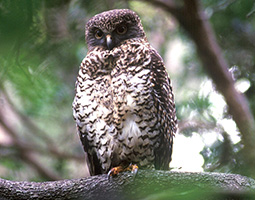Ninox strenua
Description

Powerful Owls are the largest owl in Australia, with a wingspan reaching up to 140 centimetres. They are generally found in open forests and woodlands, particularly areas that include densely sheltered gullies along waterways. The breast plate of the owl has distinctive dark v-shaped chevrons.
Unusually in raptors, the male is larger than the female. Powerful Owls need old growth tree hollows to nest. They tend to mate for life, with the female incubating the eggs (usually two) and looking after the young. Young owls remain with the parents for up to a year. Mating usually occurs during the autumn / winter months.
Adaptations
- Large eyes help them to find food at night
- Large, strong feet (talons) that it uses to subdue prey
Feeding relationships
- What I eat: possums, gliders, rabbits, bats and smaller birds including other owls
- What eats me: young owls are sometimes killed by foxes, cats or dogs
Interesting facts
Powerful Owls need large tracts of land to survive, with a home range of up to 1000 hectares. Local populations are most at threat from land clearing and human development. While the population is considered stable, they are listed as endangered in South Australia, threatened in Victoria and vulnerable in both Queensland and New South Wales.